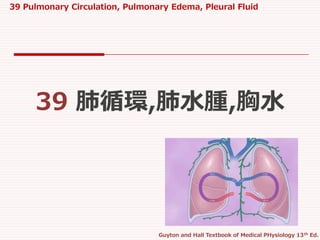
39 pulmonary circulation
- 1. 39 Pulmonary Circulation, Pulmonary Edema, Pleural Fluid Guyton and Hall Textbook of Medical PHysiology 13th Ed. 39 肺循環,肺水腫,胸水
- 2. 39 Pulmonary Circulation, Pulmonary Edema, Pleural Fluid Guyton and Hall Textbook of Medical PHysiology 13th Ed. 肺循環系の生理学的解剖
- 3. 39 Pulmonary Circulation, Pulmonary Edema, Pleural Fluid Guyton and Hall Textbook of Medical PHysiology 13th Ed. 肺血管 コンプライアンスの大きな血管系 壁が薄い 肺動脈壁は,大動脈壁の1/3の厚さ 拡張性に富んでいる. 体血管に比較して,短く,径が大きい 7ml/mmHg これが,右室の拍出量に順応してる原因.
- 4. 39 Pulmonary Circulation, Pulmonary Edema, Pleural Fluid Guyton and Hall Textbook of Medical PHysiology 13th Ed. 気管支血管 気管支動脈を介して,体血管系から肺に血液 が流入している. 心拍出量全体の1-2% 酸素化された血液 肺の支持組織(結合織,隔壁,大小の気管 支)に流入 肺静脈から左心房に流入する. よって,右心室より左心室の方が1-2%排出量が 多い.
- 5. 39 Pulmonary Circulation, Pulmonary Edema, Pleural Fluid Guyton and Hall Textbook of Medical PHysiology 13th Ed. リンパ系 リンパ管は,肺のすべての支持組織に存在. 終末気管支周囲の支持組織にはじまり, 肺門 を介して右の胸管に流入. 吸入した微粒子は,一部このリンパ系から除去 される. 肺血管から漏出した血漿蛋白も,このリンパ系 からドレナージされて,肺浮腫を防いでいる.
- 6. 39 Pulmonary Circulation, Pulmonary Edema, Pleural Fluid Gray’s Anatomy: The Anatomical Basis of Clinical Practice 40th. Ed. 右の胸管
- 7. 39 Pulmonary Circulation, Pulmonary Edema, Pleural Fluid Guyton and Hall Textbook of Medical PHysiology 13th Ed. 肺の圧
- 8. 39 Pulmonary Circulation, Pulmonary Edema, Pleural Fluid 右心室圧と肺動脈圧
- 9. 39 Pulmonary Circulation, Pulmonary Edema, Pleural Fluid 肺動脈圧
- 10. 39 Pulmonary Circulation, Pulmonary Edema, Pleural Fluid Guyton and Hall Textbook of Medical PHysiology 13th Ed. 左房圧,肺静脈圧 臥位の場合,肺静脈圧,左房圧は約2mmHg (1-5mmHg) 直接測定は,困難だが肺動脈楔入圧で代用 通常は,約5mmHg程度 (LAPより2-3mmHg高い) うっ血性心不全の患者において使用
- 11. 39 Pulmonary Circulation, Pulmonary Edema, Pleural Fluid Guyton and Hall Textbook of Medical PHysiology 13th Ed. 肺動脈楔入圧(PAWP)測定 QUICK GUIDE TO Cardiopulmonary Care P17Edwards Lifesciences
- 12. 39 Pulmonary Circulation, Pulmonary Edema, Pleural Fluid Guyton and Hall Textbook of Medical PHysiology 13th Ed. 肺内血液量 肺内血液量は,約450ml 毛細血管内に約 70ml 肺動脈,肺静脈に残りの血液が 同量づつ分布 (190ml+190ml) 全血液量の9%
- 13. 39 Pulmonary Circulation, Pulmonary Edema, Pleural Fluid Guyton and Hall Textbook of Medical PHysiology 13th Ed. 血液のリザーバーとしての肺 肺内の血液量は,正常の1/2から2倍まで変 化しうる. 肺内が高圧になる環境では, 250mlの血 液が,肺内から体循環へ駆出される. (トランペットを吹いているような場合) 大量出血の代償として,自動的に肺から体循 環に血液がシフトされる.
- 14. 39 Pulmonary Circulation, Pulmonary Edema, Pleural Fluid Guyton and Hall Textbook of Medical PHysiology 13th Ed. 心疾患による肺うっ血 肺うっ血により肺内血液量が最高2倍にまで 増量する. 左心不全 僧帽弁狭窄 僧帽弁逆流 通常体循環血液量は,肺循環血液量の9倍. したがって,体循環から肺循環へのシフトは 肺循環にとっては影響大 体循環にとっては影響小
- 15. 39 Pulmonary Circulation, Pulmonary Edema, Pleural Fluid Guyton and Hall Textbook of Medical PHysiology 13th Ed. 肺血流分布
- 16. 39 Pulmonary Circulation, Pulmonary Edema, Pleural Fluid Guyton and Hall Textbook of Medical PHysiology 13th Ed. 肺胞低酸素は,肺胞血流を減少1 肺胞気の酸素濃度が正常の70%以下にまで 低下(例 PAO2<73mmHg)すると,周囲の血 管が収縮する. 極度に酸素レベルが低いと血管抵抗は5倍以上に上 昇する. これは,体循環で低酸素状態になると血管が拡張する のと対照的である. 機序の詳細は,不明だが… 血管収縮性物質の放出? Nitric oxideのような血管拡張性物質放出の減少?
- 17. 39 Pulmonary Circulation, Pulmonary Edema, Pleural Fluid Guyton and Hall Textbook of Medical PHysiology 13th Ed. 肺胞低酸素は,肺胞血流を減少2
- 18. 39 Pulmonary Circulation, Pulmonary Edema, Pleural Fluid Guyton and Hall Textbook of Medical PHysiology 13th Ed. 肺の静水圧勾配と局所血流
- 19. 39 Pulmonary Circulation, Pulmonary Edema, Pleural Fluid Guyton and Hall Textbook of Medical PHysiology 13th Ed. 肺の高さと血流量
- 20. 39 Pulmonary Circulation, Pulmonary Edema, Pleural Fluid Guyton and Hall Textbook of Medical PHysiology 13th Ed. 3血流ゾーン
- 21. 39 Pulmonary Circulation, Pulmonary Edema, Pleural Fluid Guyton and Hall Textbook of Medical PHysiology 13th Ed. Zone 1は,異常時のみ sPAPが異常に低いか,肺胞圧が異常に高い 1. 具体例 立位で陽圧換気を受けている. 肺胞内圧は,少なくとも10mmHg 収縮期肺動脈圧は正常範囲内 2. 具体例 立位 収縮期肺動脈圧が異常低値(大量出血などで)
- 22. 39 Pulmonary Circulation, Pulmonary Edema, Pleural Fluid Guyton and Hall Textbook of Medical PHysiology 13th Ed. 運動は,すべての部分の肺血流を増加
- 23. 39 Pulmonary Circulation, Pulmonary Edema, Pleural Fluid Guyton and Hall Textbook of Medical PHysiology 13th Ed. 心拍出量の増大と肺動脈圧 重労働では,肺血流量は4-7倍にまで増加. 肺の順応 1. 開いている毛細血管の数を増加(3倍まで) 2. すべての血管径を拡張(2倍以上) 3. 肺動脈圧上昇 右心系の負担軽減 肺毛細血管圧上昇の予防 肺水腫の予防
- 24. 39 Pulmonary Circulation, Pulmonary Edema, Pleural Fluid Guyton and Hall Textbook of Medical PHysiology 13th Ed. 心拍出量と肺動脈圧
- 25. 39 Pulmonary Circulation, Pulmonary Edema, Pleural Fluid Guyton and Hall Textbook of Medical PHysiology 13th Ed. 左心不全 健康人の左房圧は,決して+6mmHgより上がらな い. 左房圧の変動が少ないために,肺からの潅流は容易 心不全では溢水から,正常圧の1-5mmHgから 40-50mmHgまで上昇する. -7mmHgまでの上昇は,肺循環に与える影響軽微. それ以上の上昇は,PA圧を上昇させ右心系の負荷↑ 30mmHg以上の上昇は,毛細血管圧上昇から肺水腫
- 26. 39 Pulmonary Circulation, Pulmonary Edema, Pleural Fluid Guyton and Hall Textbook of Medical PHysiology 13th Ed. 肺毛細血管の力学 肺毛細血管圧 isograbimetric measurement 等重量測定法 によれば, 7mmHg 血液の毛細血管内滞留時間 正常心拍出量のとき,0.8秒 心拍出量増加 0.3秒まで短縮
- 27. 39 Pulmonary Circulation, Pulmonary Edema, Pleural Fluid Guyton and Hall Textbook of Medical PHysiology 13th Ed. 肺毛細血管と肺間質との液体力学 1. 肺毛細血管圧は7mmHg. 末梢毛細血管 圧は17mmHg 2. 肺間質液圧 -5~-8mmHg 3. 肺間質膠質浸透圧 約14mmHg 末梢間質膠質浸透圧 この半分以下 4. 肺胞壁は極薄で,肺胞上皮が非常に脆弱 間質の圧が肺胞圧を上回ると(>10mmHg)間 質から肺胞に液が移動する.
- 28. 39 Pulmonary Circulation, Pulmonary Edema, Pleural Fluid Guyton and Hall Textbook of Medical PHysiology 13th Ed. 肺の間質圧と他の圧の関係 mmHg 毛細血管の内側から間質にむけて働く力: 毛細血管圧 7 間質の膠質浸透圧 14 間質の陰圧 8 合計の外向きの力 29 毛細血管内に引き込む力: 血漿コロイド浸透圧 28 合計の内向きの力 28
- 29. 39 Pulmonary Circulation, Pulmonary Edema, Pleural Fluid Guyton and Hall Textbook of Medical PHysiology 13th Ed. 毛細血管,肺胞の静水圧,膠質浸透圧
- 30. 39 Pulmonary Circulation, Pulmonary Edema, Pleural Fluid Guyton and Hall Textbook of Medical PHysiology 13th Ed. 肺胞をドライに保つ機構 肺毛細血管とリンパ系が間質の圧を陰圧に 保っている. 肺胞に水がでても,肺胞上皮細胞の小さな間 隙から,直ちに間質に吸い込まれる. さらに,リンパ系が過剰な水分を処理する.
- 31. 39 Pulmonary Circulation, Pulmonary Edema, Pleural Fluid Guyton and Hall Textbook of Medical PHysiology 13th Ed. 肺水腫 1. 左心不全,僧帽弁疾患 肺静脈圧上昇 肺毛細血管圧上昇 間質,肺胞の溢水 2. 肺毛細血管の破綻 感染 有毒ガス吸入(塩素,二酸化硫黄)
- 32. 39 Pulmonary Circulation, Pulmonary Edema, Pleural Fluid Guyton and Hall Textbook of Medical PHysiology 13th Ed. Pulmonary Edema Safety Factor
- 33. 39 Pulmonary Circulation, Pulmonary Edema, Pleural Fluid Guyton and Hall Textbook of Medical PHysiology 13th Ed. 胸腔内の液
- 34. 39 Pulmonary Circulation, Pulmonary Edema, Pleural Fluid Guyton and Hall Textbook of Medical PHysiology 13th Ed. 胸腔内の水交換の動態
- 35. 39 Pulmonary Circulation, Pulmonary Edema, Pleural Fluid Guyton and Hall Textbook of Medical PHysiology 13th Ed. 胸腔の陰圧 リンパ管による胸水ドレナージが,陰圧のもと. 肺の虚脱傾向は, -4mmHg よって,胸腔内圧は,少なくとも-4mmHg 以上の陰圧である必要がある. 実測では,胸腔内圧は, -7mmHg
- 36. 39 Pulmonary Circulation, Pulmonary Edema, Pleural Fluid Guyton and Hall Textbook of Medical PHysiology 13th Ed. 胸水 胸腔の浮腫 1. リンパドレナージの障害 2. 心不全 (末梢,肺毛細血管圧上昇による 漏出) 3. 血漿膠質浸透圧の著しい低下 4. 胸膜面の炎症 透過性亢進による血漿蛋白,液の浸出.